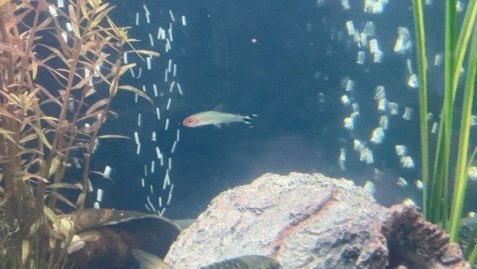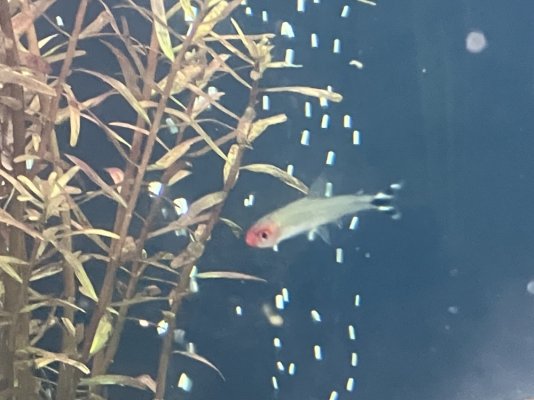Spider8ait1994
Aquarium Advice Apprentice
I bought a school of Rummy Nose Tetras recently and one of them I am concerned about.
I’ve kept neons and Cardinals before but this is my first time keeping the Rummy Nose variety.
1~What type of fish is afflicted? In addition, please describe what is wrong with the fish to the best of your ability:
Species: Rummy Nose Tetra.
Concern: appears skinny and is often seperate from the school. Has been this way since I acquired it from the store.
2~What are your tank parameters (ammonia, nitrites, nitrates, temp, pH)? Please give exact values.
pH: 7
Ammonia: 0ppm
Nitrite: 0ppm
Nitrate: 0.25ppm
Temp: 26°C
3~ How large is the tank? How long has the tank been set up?
Tank size: 130 Litre
Time since setup: 2 months
4~What type of filtration are you using? Please give the name and number and amount of gph if known.
Filtration: Aqua One Aquis 750 canister filter with spray bar output positioned just below the waters surface.
5~How many fish are in the tank? What kinds of fish are they and what are their current sizes?
8 Rummy Nose Tetras (this includes the one I’m asking about), 4 Cardinal Tetras and 1 Neon Tetra (the 1 neon was mixed in with the cardinals when I got them), 2 Pearl Gourami, 1 Coral Blue Dwarf Gourami, 1 Flame Dwarf Gourami, 2 Angelfish, 2 Spotted Silver Dollars, 2 Swordtails, 2 Pakistani Loach, 2 Siamese Algae Eaters, 2 Bristlenose Plecos, 3 Corydora (1 albino, 1 peppered and 1 Julii leopard)
Sizes: all tetras are ~2-2.5cm, both dwarf Gourami are ~4cm, the Pearl Gourami, spotted silver dollars, albino cory and 1 Angel are 4-5cm, both loach are 2.5cm, peppered cory is ~3 cm, leopard cory is 2.5cm, SAEs are both ~6cm and both Plecos are 6cm.
6~When is the last time you did a water change and vacuum the gravel? How often do you do this? How much water do you remove at a time?
Last water change: 3 weeks ago
Gravel vac: 3 weeks ago
Frequency: monthly at the most but if things still look good I’ll leave it a bit longer (ie an extra week or so)
% water change: ~30-40%
7~How long have you had the fish? If the fish is new, how did you acclimate it/them?
Timeframe: I got the Rummy Nose Tetras approximately 2 weeks ago.
Acclimation: I floated the bag in the tank for 10 minutes, after that I opened the bag and added some of the tank water in and let that sit for another 10 minutes before releasing the school into the tank.
8~Have you added anything new to the tank--decor, new dechlorinator, new substrate, etc.?
1 upright tree stump ornament (resin) and some live aquatic plants (blue stricta, variegated lime rush) all of which were washed/rinsed prior to adding in.
9~What kind of food have you been feeding your fish, have you changed their diet recently?
Food: I use Tetra brand Corywafers for the corys and loach, Tetra brand Plecowafers for the Plecos, Tetra brand XL Tropical color granules for the gourami, angels, spotted silver dollars and swordtails, the tetras eat API brand betta pellets though today I picked up some Pisces brand micro pellets in the hopes that the tetra I concerned about would be able to better eat the smaller sized food. The SAEs are happy to scavenge any leftover food that escapes the other fish.
I’m addition to this I also occasionally (once a month) drop in a frozen bloodworm cube.
I have attached a photo and also a gif of the tetra I’m concerned about. In the gif you can see the school swim past which helps show how skinny the one I’m asking about it in comparison. (Or maybe not…no idea what’s going on but it keeps uploading my gif file as a jpg…)
If anyone knows what’s going on and/or has any advice that would be great.
I’ve kept neons and Cardinals before but this is my first time keeping the Rummy Nose variety.
1~What type of fish is afflicted? In addition, please describe what is wrong with the fish to the best of your ability:
Species: Rummy Nose Tetra.
Concern: appears skinny and is often seperate from the school. Has been this way since I acquired it from the store.
2~What are your tank parameters (ammonia, nitrites, nitrates, temp, pH)? Please give exact values.
pH: 7
Ammonia: 0ppm
Nitrite: 0ppm
Nitrate: 0.25ppm
Temp: 26°C
3~ How large is the tank? How long has the tank been set up?
Tank size: 130 Litre
Time since setup: 2 months
4~What type of filtration are you using? Please give the name and number and amount of gph if known.
Filtration: Aqua One Aquis 750 canister filter with spray bar output positioned just below the waters surface.
5~How many fish are in the tank? What kinds of fish are they and what are their current sizes?
8 Rummy Nose Tetras (this includes the one I’m asking about), 4 Cardinal Tetras and 1 Neon Tetra (the 1 neon was mixed in with the cardinals when I got them), 2 Pearl Gourami, 1 Coral Blue Dwarf Gourami, 1 Flame Dwarf Gourami, 2 Angelfish, 2 Spotted Silver Dollars, 2 Swordtails, 2 Pakistani Loach, 2 Siamese Algae Eaters, 2 Bristlenose Plecos, 3 Corydora (1 albino, 1 peppered and 1 Julii leopard)
Sizes: all tetras are ~2-2.5cm, both dwarf Gourami are ~4cm, the Pearl Gourami, spotted silver dollars, albino cory and 1 Angel are 4-5cm, both loach are 2.5cm, peppered cory is ~3 cm, leopard cory is 2.5cm, SAEs are both ~6cm and both Plecos are 6cm.
6~When is the last time you did a water change and vacuum the gravel? How often do you do this? How much water do you remove at a time?
Last water change: 3 weeks ago
Gravel vac: 3 weeks ago
Frequency: monthly at the most but if things still look good I’ll leave it a bit longer (ie an extra week or so)
% water change: ~30-40%
7~How long have you had the fish? If the fish is new, how did you acclimate it/them?
Timeframe: I got the Rummy Nose Tetras approximately 2 weeks ago.
Acclimation: I floated the bag in the tank for 10 minutes, after that I opened the bag and added some of the tank water in and let that sit for another 10 minutes before releasing the school into the tank.
8~Have you added anything new to the tank--decor, new dechlorinator, new substrate, etc.?
1 upright tree stump ornament (resin) and some live aquatic plants (blue stricta, variegated lime rush) all of which were washed/rinsed prior to adding in.
9~What kind of food have you been feeding your fish, have you changed their diet recently?
Food: I use Tetra brand Corywafers for the corys and loach, Tetra brand Plecowafers for the Plecos, Tetra brand XL Tropical color granules for the gourami, angels, spotted silver dollars and swordtails, the tetras eat API brand betta pellets though today I picked up some Pisces brand micro pellets in the hopes that the tetra I concerned about would be able to better eat the smaller sized food. The SAEs are happy to scavenge any leftover food that escapes the other fish.
I’m addition to this I also occasionally (once a month) drop in a frozen bloodworm cube.
I have attached a photo and also a gif of the tetra I’m concerned about. In the gif you can see the school swim past which helps show how skinny the one I’m asking about it in comparison. (Or maybe not…no idea what’s going on but it keeps uploading my gif file as a jpg…)
If anyone knows what’s going on and/or has any advice that would be great.


